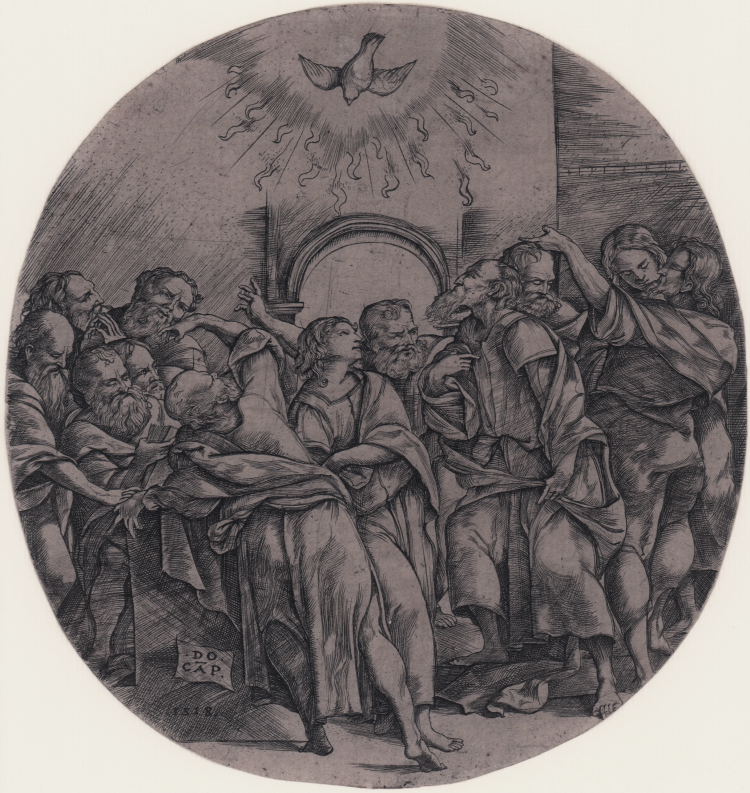




| Reference: | S30749 |
| Author | Domenico CAMPAGNOLA |
| Year: | 1518 |
| Measures: | 173 x 183 mm |



| Reference: | S30749 |
| Author | Domenico CAMPAGNOLA |
| Year: | 1518 |
| Measures: | 173 x 183 mm |
Engraving dated 1518 and signed DO. CAP. A fine impression, printed on contemporary laid paper, trimmed to the borderline, perfect conditions.
According to the Acts of Apostles (2:1-4), on the day of Pentecost the Holy Spirit descended upon the apostles and the Virgin, gathering to pray, in the form of individual flames. All of them were filled with the Holy Spirit and began to speak in other tongues as the Spirit enabled them.
The typical iconography shows the Virgin as the central figure of the composition, therefore, the absence of her in the work by Campagnola is quite unusual.
The excited group here seems more appropriate for an Assumption of the Virgin, and the arrangement and actions of the figures are indeed comparable to the apostles in Domenico’s own Assumption, and in the famous altarpiece by Titian of 1516-18.The composition of the print is based on a drawing in the Louvre of a group of apostles executed with an Assumption of the Virgin or perhaps a Ascension of Christ.
The drawing is similar to our print, in reverse, in a number of figures and in much of the general composition, and has been traditionally taken as a preparatory design by Titian for the Frari Assumption and for his Pentecost of c. 1550 in S. Maria della Salute in Venice.
Oberhuber has ascribed it to Domenico himself as a reflection of a lost early stage in the genesis of the altarpiece in the Frari. Since he had already engraved an Assumption of the Virgin, he adapted the design to portray another excited gathering of the apostles, the Descent of the Holy Spirit.
A comparison with the early Assumption shows that the later composition is clearer in structure and richer both in movement and spatial layout. This development, according to Oberhuber, is the result of Titian’s influence; Domenico clearly studied his work very intensely at this moment and may even have studied with him.
A fine example of this very rare work.
|
Levenson-Oberhuber-Sheehan, Early Italian Engraving, n. 158 p. 434; M. J. Zucker I TIB.25.19.003; Hind, V, p. 168 n.3. Dimensioni 173x183.
|
Domenico CAMPAGNOLA (Venezia 1500 – Padova 1564)
|
Adopted son of Giulio Campagnola. He was of German extraction and was apprenticed to Giulio in Venice c. 1507. A group of drawings of pastoral subjects, indebted to Giorgione and to Dürer, includes the slightly tentative Landscape with Two Youths (London, BM) and Landscape with Boy Fishing (Washington, DC, N.G.A.) and may be dated to his earliest years, perhaps before 1517. His independent career began in 1517–18 with a group of engravings and woodcuts that are largely independent of Giulio Campagnola but clearly indebted to the work of Titian. Indeed, the close correspondence between Domenico’s work and Titian’s has led to suggestions that Domenico was responsible for the forged Titian drawings taken from counterproofs of the master’s woodcuts. Domenico’s own prints are executed in an unusually flowing and sketchy technique and include enigmatic, pastoral themes, such as the Shepherd and Old Warrior (1517), which recalls the moody poetry of Giorgione, and religious subjects, such as the Assumption of the Virgin (1517). This latter depends on Titian’s painting of that subject (Venice, Frari), completed the following year, which suggests that Domenico had access to Titian’s workshop. Domenico’s main innovation was in the technique of the woodcut, and it is evident that he cut the blocks himself rather than relying on a professional cutter. The energy of the unusually bold Vision of St Augustine is indebted to such works as Titian’s woodcut of St Jerome, cut by Ugo da Carpi.
|
|
Levenson-Oberhuber-Sheehan, Early Italian Engraving, n. 158 p. 434; M. J. Zucker I TIB.25.19.003; Hind, V, p. 168 n.3. Dimensioni 173x183.
|
Domenico CAMPAGNOLA (Venezia 1500 – Padova 1564)
|
Adopted son of Giulio Campagnola. He was of German extraction and was apprenticed to Giulio in Venice c. 1507. A group of drawings of pastoral subjects, indebted to Giorgione and to Dürer, includes the slightly tentative Landscape with Two Youths (London, BM) and Landscape with Boy Fishing (Washington, DC, N.G.A.) and may be dated to his earliest years, perhaps before 1517. His independent career began in 1517–18 with a group of engravings and woodcuts that are largely independent of Giulio Campagnola but clearly indebted to the work of Titian. Indeed, the close correspondence between Domenico’s work and Titian’s has led to suggestions that Domenico was responsible for the forged Titian drawings taken from counterproofs of the master’s woodcuts. Domenico’s own prints are executed in an unusually flowing and sketchy technique and include enigmatic, pastoral themes, such as the Shepherd and Old Warrior (1517), which recalls the moody poetry of Giorgione, and religious subjects, such as the Assumption of the Virgin (1517). This latter depends on Titian’s painting of that subject (Venice, Frari), completed the following year, which suggests that Domenico had access to Titian’s workshop. Domenico’s main innovation was in the technique of the woodcut, and it is evident that he cut the blocks himself rather than relying on a professional cutter. The energy of the unusually bold Vision of St Augustine is indebted to such works as Titian’s woodcut of St Jerome, cut by Ugo da Carpi.
|